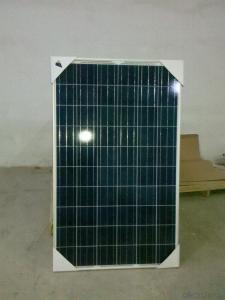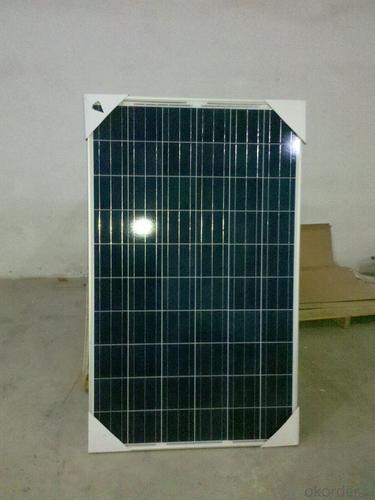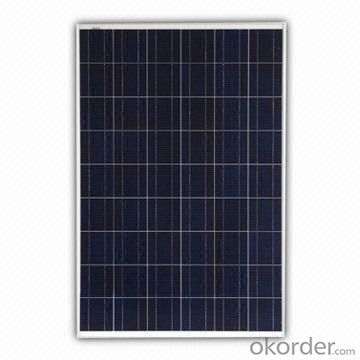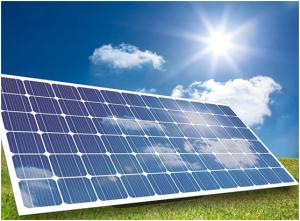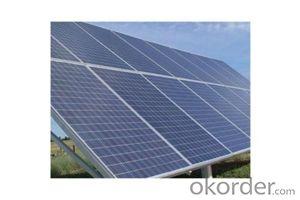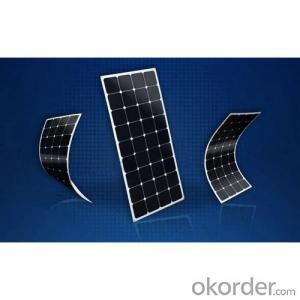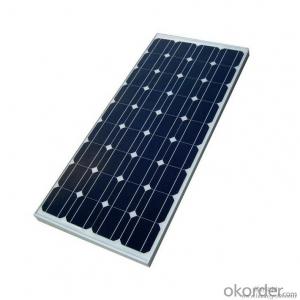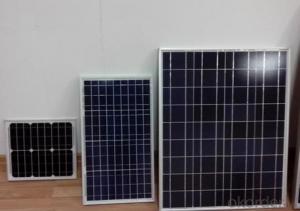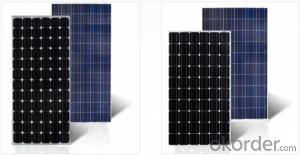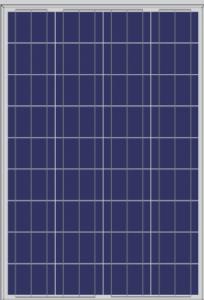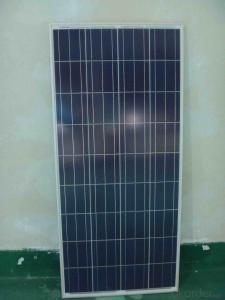Commercial Grade Solar Panels - Solar Polycrystalline 156mm Series (130W-150W)
- Loading Port:
- Shanghai
- Payment Terms:
- TT OR LC
- Min Order Qty:
- 1000 watt
- Supply Capability:
- 20000000 watt/month
OKorder Service Pledge
OKorder Financial Service
You Might Also Like
Specification
1.Structure of Solar Module Description
Solar Polycrystalline 156mm Series (130W-----150W)
2.Characteristics of the Solar Module
| Max Power Voltage Vmp (V) | 17.5 | 17.8 | 18.0 |
| Max Power Current Imp (A) | 7.42 | 7.86 | 8.33 |
| Open Circuit Voltage Voc (V) | 22.0 | 22.4 | 22.6 |
| Short Circuit Current Isc (A) | 8.10 | 8.34 | 8.91 |
| Max Power Pm(W) | 130 | 140 | 150 |
3.Limits of the Solar Module
Operating Temperature ﹣40℃to+85℃
Storage Temperature ﹣40℃to+85℃
Max System Voltage 700V
4.Specifications of the Solar Module
| Power | 130W/140W/150W |
| Dimension | 1470x670x30mm |
| Weight | 11.7kg |
| Tolerance | ±3% |
The dimension of the modules can be changed according to the demand of clients
5.Guarantee of the Solar Module
| Products Guarantee | 2 yrs free from defects in materials and
workmanship |
| Performance Guarantee | No less than 90% within 10yrs and no less than 80% within 20yrs |
| Certificates | IEC,ISO,TUV,CE |
6.Applications of the Solar Module
1.Electricity
2.Heat energy
7.IMages of the Solar Module
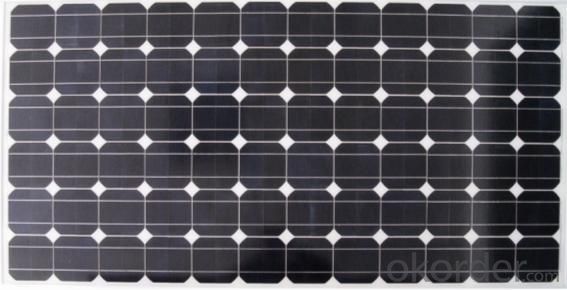
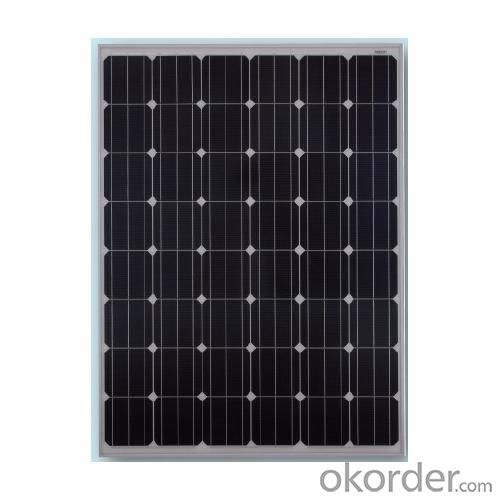
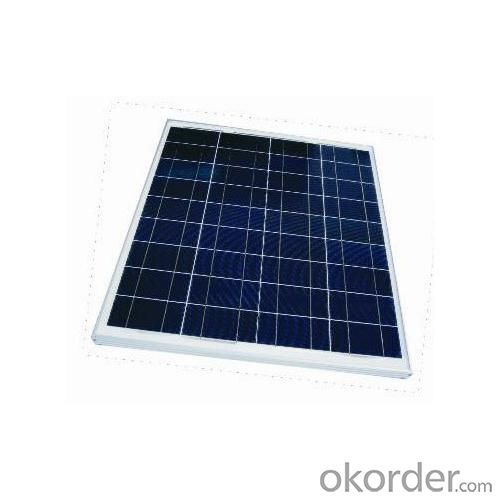
FAQ
1. Q: Do you have your own factory?
A: Yes, we have. Our factory located in Jiangyin city, jiangsu province.
2. Q: How can I visit your factory?
A: Before you take off from your country, please let us know. We will show you the way,or arrange time to pick you up if possible.
3. Q: Do you provide free sample?
A: Usually we do not offer free sample
4. Q: Could you print our company LOGO on the nameplate and package?
A: Yes, we can do that.
- Q: Can solar panels be installed on a concert venue or entertainment facility?
- Yes, solar panels can be installed on a concert venue or entertainment facility. In fact, many large entertainment venues have already embraced solar energy to reduce their carbon footprint and lower energy costs. Installing solar panels on the roof or surrounding areas of these facilities can generate clean and renewable electricity, which can be used to power the venue's operations or be fed back into the grid. Additionally, solar panels can serve as a visible commitment to sustainability, inspiring others to adopt renewable energy solutions.
- Q: do solar panels create electricity from the ultraviolet light created from the sun? because they only have an efficientcy of like 8% and this scientist found out a way to collect the visible light also, and he says the solar panel could have an effeciency of up to 80%! so my question really is, do solar penels creat electricity from heat? do you know of anything that can?
- They create electricity from light energy provided by the sun....
- Q: What are the financial benefits of installing solar panels?
- There are several financial benefits of installing solar panels. Firstly, solar panels help to significantly reduce or even eliminate electricity bills, as they generate free and renewable energy from the sun. Additionally, in many countries, homeowners can sell excess electricity generated by their solar panels back to the grid, earning them credits or money. Furthermore, installing solar panels can increase the value of a property, making it more attractive to potential buyers in the future. Lastly, solar panel owners can take advantage of various government incentives, tax credits, and rebates, which can further reduce the upfront cost of installation and provide long-term savings. Overall, solar panels offer a cost-effective and sustainable solution that can lead to significant financial savings over their lifespan.
- Q: Can solar panels be used to heat water?
- Yes, solar panels can be used to heat water. Solar water heating systems use the sun's energy to heat water, typically through the use of solar thermal collectors. These collectors absorb sunlight and transfer the heat to water, which can then be used for various purposes such as bathing, washing, or even space heating.
- Q: Can solar panels be used for powering a water treatment plant?
- Yes, solar panels can be used to power a water treatment plant. Solar energy can be converted into electricity to run the necessary equipment and processes involved in treating water, making it a sustainable and environmentally friendly option for powering such facilities.
- Q: Installing solar panels requires a big initial investment. Before I make this investment I want to check to see if the money I will save by installing solar panels will actually pay for this investment, in the long run. To calculate my savings, we should consider the area (square feet) I currently have available to install solar panels. Look at the available sunlight and its intensity in my state each month of the year. Based on this data estimate how much energy my solar panel will generate. Then compare that with how much energy (kWh) I currently consume based on my electricity bill.
- Only by doing the calculations (figuring out how much you electricity bill is per month now and calculate how much time it will take to get to the figure of your solar panels. Don't forget to add a couple of percentage points per year higher(since when has electrical costs gone down)? and do the addition. That is when you will pay off the solar panels, as their power is free.
- Q: Does San Francisco get enough sunshine to really make solar panels a viable option for creating a self-supporting home? Certainly a wind turbine would be a good source of energy, but what about solar panels? Does S.F. get enough sunshine to justify using solar panels? It's overcast a lot in the Bay Area, are there any solar panels better than others for a climate like this?
- I know nothing about the Bay area, I live in KC. However, I believe that solar is the best answer to alternative energy. We should have solar panels everywhere, the suns going to be shining somewhere. I propose we make gigantic panels in the deserts where the sun shines and nobody lives, and hook everybody up to the grid. They can store energy when they get a lot of sun to make up for the dark days. They are expensive to make so we should start building them one by one all over. The sun is not going to stop shining for millions of years. Plus there is no pollution from solar. So, yes put them in the bay and back here in KC too.
- Q: How do you make solar panels and do you need a lot of them to make electricity?
- Homemade okorder
- Q: What is the most efficient solar panel, how many would we need to power the United States, and how much land would it take?
- Annual power consumption in the US is approximately .2*0^5 Watt-hours. The average solar panel can generate 80W continuously. We can break up the calculation into parts: .2*0^5 Watt-hours per year 925 hours per year .3*0^ continuous watts 80W per panel 64383566 panels 000 sq. inches average solar panel area 650 million square miles (!!!) To give you a better idea, the total surfacre area of the United States of America is 3 million square miles. The surface of the earth is 96 million square miles. Not even 3 planets full of solar panels would be enough. Maybe it is easier for people to start using electricity more responsibly?
- Q: I have this question for extracredit and I dont get it?How many 2V,2W PV panels would be required to supply a load that requires a 48-volt supply that can push at least 2.8 amps of current, if you assume each panel puts out A at 2 V? And how are the panels configured to supply the power requirements of the load?
- i agree with Liz but have a diffrent point i think u have not calculated for the roof mounted solar panels i am giving youy a bsic understanding hope that will help you Roof Mounted solar power systems consist of solar panels held in place by racks or frames which are attached to roof based mounting supports. Roof based mounting supports include: Pole mounts which are attached directly to the roof structure and may use additional rails for attaching the panel racking or frames. Ballasted footing mounts such as concrete or steel bases that use weight to secure the panel system in position and do not require through penetration. This mounting method allows for decommisison or relocation of solar panel systems with no impact on the roof structure.
Send your message to us
Commercial Grade Solar Panels - Solar Polycrystalline 156mm Series (130W-150W)
- Loading Port:
- Shanghai
- Payment Terms:
- TT OR LC
- Min Order Qty:
- 1000 watt
- Supply Capability:
- 20000000 watt/month
OKorder Service Pledge
OKorder Financial Service
Similar products
Hot products
Hot Searches
Related keywords
